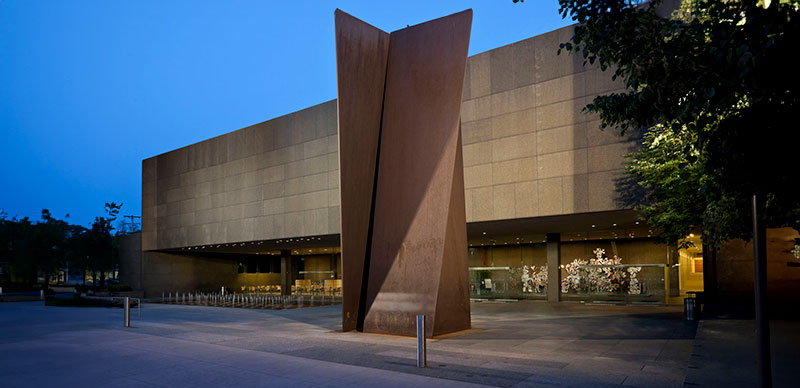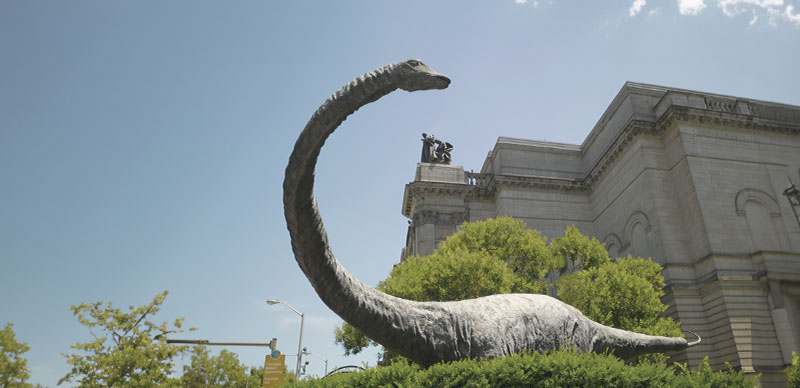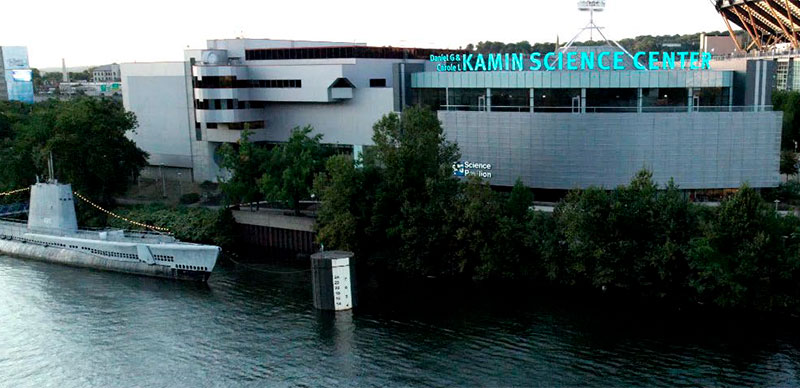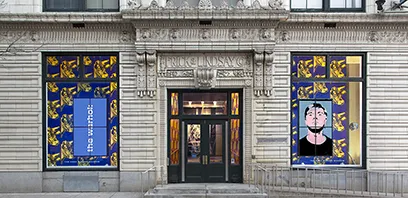Contents
Back Issues�
Membership
Demolition of old railroad station of
Federal Street, Northside
By Ellen S. Wilson
Dream Street: W. Eugene Smith�s
Pittsburgh Photographs
Carnegie Museum of Art
November 3, 2001 – February 10, 2002
����������� �Don�t expect,� wrote photographer
W. Eugene Smith, �a point-by-point hand-led tour.� This is an experience as an intensely
curious visitor (perhaps a new resident) might discover it.��
Smith wrote those notes to himself as he began
his Pittsburgh project, what he later called �the finest set of
photographs I have ever produced.��
With a clear vision and a spectacular result, it is puzzling that
Smith also considered the project as a failure, and that until now the
final results have never been exhibited together.
Dream
Street: W. Eugene Smith�s Pittsburgh Photographs, curated by Sam Stephenson of the Center for
Documentary Studies at Duke University, opens at Carnegie Museum of Art November 3.
Smith was born in Wichita, Kansas, in 1918.� His mother, Nettie
Lee Caplinger Smith, was an amateur photographer.� His father, William, lost his grain
business in 1936 and shot himself.�
Doctors were unable to save him with a blood transfusion from Gene.
Smith had already had one photograph, of the
drought-parched bed of the Arkansas
River, appear in the New York Times.� Shortly
after his father�s suicide, he left Kansas and enrolled at the University of Notre Dame on
a photography scholarship.� School
did not suit Smith, however, and he left after one year and moved to New York, where he worked on free-lance assignments.
It was
during World War II, photographing combat at close range and becoming
involved personally with the soldiers, that Smith�s sense of mission and
its role in his photography began to emerge.� As Stephenson writes in Dream Street: W. Eugene Smith�s
Pittsburgh Project (W.W. Norton and Company and the Center for
Documentary Studies at Duke University [a Lyndhurst Book],
2001), �His pictures began to express a tragic lyricism infused with a
benevolent melancholy.� He shaded his
prints with ever-deepening contrasts between dark and light, creating a
visual metaphor for the basic struggle that he was witnessing in
civilization, and feeling waged within himself.�
Badly wounded in the head and left hand in 1945,
Smith spent a year recovering and then, as a well-paid staff member at Life, completed more than 50
assignments for the magazine.� Some
of those photo-essays, Stephenson says, are �among the most significant in
the history of photojournalism.�
Life in those pre-television days was a dominant
cultural force as well as a major news source, and a position such as Smith
had was a rare opportunity.� Smith,
however, was not happy.� He wanted
complete control over printing his negatives and arranging his layouts,
spent much more time on small assignments that his editors felt was
necessary, and was generally cantankerous and difficult to deal with. �The
magazine wanted a reliable photographer who could accept the boundaries of
given assignments and meet deadlines,� Stephenson writes. �Smith wanted to
change the world with his pictures.�
Shriner Circus Parade,� Sixth Street Bridge
All of this is well documented in his numerous
notes to himself and letters to family and friends, of which he kept
copies.� �He had a significant ego and
some of his copied letters feel like a paper trail left by him for future
researchers to follow,” Stephenson says.� “He liked being known as the
tortured artist.� I think he loved
that legend, fed off of it and fueled it.�
This ego, his burgeoning ambitions, and the
recurrent conflicts with his editors led Smith to resign from Life and then
try to prove he could survive without it.�
“Smith would have tried something this large no matter where he
had gone,” Stephenson says.� His
mother, long a powerful presence in his life, had recently died, and Smith
“erupted with
this
massive project.�� He was primed for
something like this.� But we are
lucky that it was Pittsburgh.� He caught one of the most
richly historic and important American cities in its prime.”
Shadyside chamber of commerce
carnival
When
Stefan Lorant hired Smith to produce 100 photographs of contemporary
Pittsburgh for a book in honor of the city�s bicentennial, it was
impossible for the job not to grow well beyond its assigned boundaries.
�Pittsburgh at that time was an industrial dynamo,� says
Linda Batis, associate curator of contemporary art at Carnegie Museum of
Art, who organized the exhibition for Pittsburgh.� �It was
so important to the American economy, and the city was at a moment of
tremendous transition.�
Smith, in transition as well, found something of
a portrait of himself here.�
Stephenson writes, �The haunting, eternal elements of an evolving,
conflicted modern world � elements that first entered his photography in a
much different setting during World War II � were on display in everyday
Pittsburgh:� simultaneous images of
glory and despair, production and destruction, past and present, human and
machine, the individual and collective, the ordinary and spectacular.�
�He was aware,� Batis agrees, �of the human undercurrent.
You see the Duquesne Club next to kids playing in the dirt � and there is
no doubt that the kids are having fun.
�On the one hand, he had an agenda,� she
explains.� �On the other, he was
trying to create a tapestry of the city by photographing disparate elements
and weaving them together, and it was the weaving together that gave him
such a hard time.�
����������� Smith fell into the same sort of
conflicts over artistic control with Lorant that he had had with Life.� He finally fulfilled his obligation by turning
in the required prints (two years after beginning the planned three-week
assignment) and then, aided by two Guggenheim fellowships, worked to
organize the Pittsburgh photographs and find a publisher.�
����������� Again, however, Smith�s need for
complete editorial control prevented most magazines from accepting his
conditions.� He finally published a
selection of Pittsburgh photographs in 38 pages of Photography Annual 1959, and wrote the accompanying text.� An editor, however, might have been
helpful.� Smith was accustomed to the
larger pages of Life, and his
layouts did not do justice to his pictures, nor did his text.� Smith himself called the result �a
debacle.�
����������� While a few of the photographs
appeared in scattered publications and one retrospective exhibition, Smith
turned his attention to other projects � the important series on the
effects of poisoned sea water in Minimata, Japan, as well as scenes outside
his Sixth Avenue loft in New York.�
The turmoil of his personal life � rocky marriages, a dependence on
speed, and never enough money � continued to rage, and his health to
deteriorate, until his death in 1978 after a massive stroke.
����������� The simple history of the
Pittsburgh Project still does not explain why the photographs have not been
given a museum exhibition until now.�
One reason, according to Stephenson, is Pittsburgh itself, and the fact that its placement in middle America has kept it off the world�s cultural radar
screen.� �For some reason, here in
the United
States we ignore cities like Pittsburgh,� he says.�
�If Smith had done an essay of this magnitude on New York or London or Paris, it would have been exhibited by now.��
����������� Additionally, Smith�s most
famous photographs tend to be portraits of individuals, but in this
project, the city itself is the individual.�
That was Smith�s intention.�
The result, however, is atypical of his body of work.
����������� And finally, Stephenson
speculates that Smith�s own personality accounts in part for the neglect of
the project.� �We�re just now
beginning a reassessment of his entire body of work,� he explains.� �Smith�s personality was enormous, and he
rubbed a lot of people in the official photography world the wrong way. . .
. I think we
needed
20 years of separation to start looking at his career anew.�
����������� The exhibition is made up
primarily of photographs in the collection of Carnegie Museum of Art, 500
of which were donated to Carnegie Library of Pittsburgh by Stefan Lorant
and given to the Museum of Art in 1982.�
One third of the photographs are from the collection of the W.
Eugene Smith Archive at the Center for Creative Photography at the University of Arizona.
����������� �While the exhibition is not a
reconstruction � nobody can get into an artist�s head � it is modeled on
what Smith might have done,� Batis explains.� Of the 16,000 negatives Smith shot, he
repeatedly singled out about 200, and those are the ones being shown
here.� After an introductory section,
there are ten thematic sections loosely modeled on themes that interested
Smith.� A room at the end of the
exhibition will include a selection of 5 x 7 work prints, arranged, the way
Smith did, on boards.�
����������� �This section will elucidate how
he cropped, how he picked images out of larger shots,� Batis says.� �It is a resource area intended to flesh
out the process through which he worked.�
Smith was a very thoughtful photographer, and he would go back to
places again and again to catch them at a particular time of day.�
����������� While Smith�s perfectionism and
sense of mission made him a great documentary photographer, they exacted a
high price.� Two years before he came
to Pittsburgh, he wrote his mother, �I have a cult of followers throughout
the world who look up to me as the shining light and the protector of
integrity and as the one who never compromises my beliefs before pressures
of the commercial and outside world.�
Perhaps this . . . is a reason I am unhappy because I am afraid I
will let these people and the world down. . . .�
����������� Such an ego can be a
burden.� The image of the tormented
artist was one Smith cultivated, as Stephenson says, but the torment,
avoidable or not, was real.� Smith�s
inability to compromise on anything made him a difficult employee, husband,
and friend, but gave the world an opportunity to see itself in unflinching
light and dark.�
Contents
Back Issues�
Membership
Copyright (c) 2001 CARNEGIE magazine
All rights reserved.
E-mail: carnegiemag@carnegiemuseums.org



